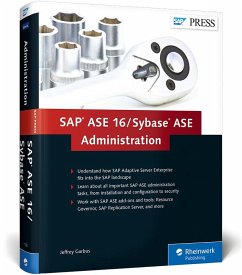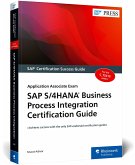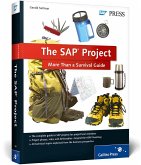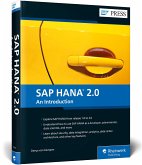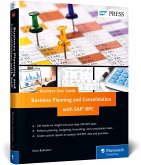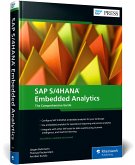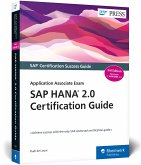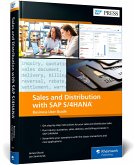Jeffrey R. Garbus
SAP ASE 16 / Sybase ASE Administration
Jeffrey R. Garbus
SAP ASE 16 / Sybase ASE Administration
- Gebundenes Buch
- Merkliste
- Auf die Merkliste
- Bewerten Bewerten
- Teilen
- Produkt teilen
- Produkterinnerung
- Produkterinnerung
Skip the marketing jargon, and jump right into the heart of the major tasks for administering SAP ASE 16. Starting with an introduction to the database and an installation overview, this book is packed with you'll use on any platform. Get the information you need to define database storage areas, create database elements, work with security and user roles, manage backup and restoration, achieve high availability, and more.
SAP ASE 16Get all of the details for the newest release of ASE, including high availability and DBA tools.
Core Database TasksCement your administration skills on…mehr
Andere Kunden interessierten sich auch für
![SAP S/4hana Business Process Integration Certification Guide SAP S/4hana Business Process Integration Certification Guide]() Murat AdivarSAP S/4hana Business Process Integration Certification Guide65,99 €
Murat AdivarSAP S/4hana Business Process Integration Certification Guide65,99 €![The SAP Project The SAP Project]() Gerald SullivanThe SAP Project44,99 €
Gerald SullivanThe SAP Project44,99 €![SAP Hana 2.0 SAP Hana 2.0]() Denys van KempenSAP Hana 2.067,99 €
Denys van KempenSAP Hana 2.067,99 €![Business Planning and Consolidation with SAP Bpc: Business User Guide Business Planning and Consolidation with SAP Bpc: Business User Guide]() Onur BekmezciBusiness Planning and Consolidation with SAP Bpc: Business User Guide68,99 €
Onur BekmezciBusiness Planning and Consolidation with SAP Bpc: Business User Guide68,99 €![SAP S/4hana Embedded Analytics SAP S/4hana Embedded Analytics]() Jürgen ButsmannSAP S/4hana Embedded Analytics73,99 €
Jürgen ButsmannSAP S/4hana Embedded Analytics73,99 €![SAP Hana 2.0 Certification Guide: Application Associate Exam SAP Hana 2.0 Certification Guide: Application Associate Exam]() Rudi de LouwSAP Hana 2.0 Certification Guide: Application Associate Exam68,99 €
Rudi de LouwSAP Hana 2.0 Certification Guide: Application Associate Exam68,99 €![Sales and Distribution with SAP S/4hana: Business User Guide Sales and Distribution with SAP S/4hana: Business User Guide]() James OlcottSales and Distribution with SAP S/4hana: Business User Guide65,99 €
James OlcottSales and Distribution with SAP S/4hana: Business User Guide65,99 €-
-
-
Skip the marketing jargon, and jump right into the heart of the major tasks for administering SAP ASE 16. Starting with an introduction to the database and an installation overview, this book is packed with you'll use on any platform. Get the information you need to define database storage areas, create database elements, work with security and user roles, manage backup and restoration, achieve high availability, and more.
SAP ASE 16Get all of the details for the newest release of ASE, including high availability and DBA tools.
Core Database TasksCement your administration skills on topics like data partitioning, preventative maintenance, memory configuration, and more.
SAP ASE-Specific ToolsEvery database is different. Learn how SAP ASE provides tools like the Logical Process Manager to prioritize resources, the Query Processor for cost-based optimization, and the Replication Server for syncing.
Highlights:
Database logging and recoverySecurityAuditingNamed cachesRemote procedure callsSAP ASE connectivityResource GovernorHigh availability and disaster recoveryRemote server managementMemory configuration
Hinweis: Dieser Artikel kann nur an eine deutsche Lieferadresse ausgeliefert werden.
SAP ASE 16Get all of the details for the newest release of ASE, including high availability and DBA tools.
Core Database TasksCement your administration skills on topics like data partitioning, preventative maintenance, memory configuration, and more.
SAP ASE-Specific ToolsEvery database is different. Learn how SAP ASE provides tools like the Logical Process Manager to prioritize resources, the Query Processor for cost-based optimization, and the Replication Server for syncing.
Highlights:
Database logging and recoverySecurityAuditingNamed cachesRemote procedure callsSAP ASE connectivityResource GovernorHigh availability and disaster recoveryRemote server managementMemory configuration
Hinweis: Dieser Artikel kann nur an eine deutsche Lieferadresse ausgeliefert werden.
Produktdetails
- Produktdetails
- SAP PRESS Englisch
- Verlag: Rheinwerk Verlag / SAP PRESS
- Artikelnr. des Verlages: 459/21182
- Seitenzahl: 720
- Erscheinungstermin: 4. März 2015
- Englisch
- Abmessung: 236mm x 181mm x 48mm
- Gewicht: 1470g
- ISBN-13: 9781493211821
- ISBN-10: 149321182X
- Artikelnr.: 41601746
- Herstellerkennzeichnung
- Libri GmbH
- Europaallee 1
- 36244 Bad Hersfeld
- gpsr@libri.de
- SAP PRESS Englisch
- Verlag: Rheinwerk Verlag / SAP PRESS
- Artikelnr. des Verlages: 459/21182
- Seitenzahl: 720
- Erscheinungstermin: 4. März 2015
- Englisch
- Abmessung: 236mm x 181mm x 48mm
- Gewicht: 1470g
- ISBN-13: 9781493211821
- ISBN-10: 149321182X
- Artikelnr.: 41601746
- Herstellerkennzeichnung
- Libri GmbH
- Europaallee 1
- 36244 Bad Hersfeld
- gpsr@libri.de
Jeffrey Garbus has a B.S. from Rensselaer Polytechnic Institute, and has worked with everything from PCs to mainframes and back again. He has decades of client/server, Sybase, and Microsoft SQL Server experience, with a special emphasis on assisting clients in migrating from existing systems to pilot and large-scale projects with very large databases. Jeff has spoken at user conferences and user groups since the early 1990s, has written articles and columns for many magazines nationally and internationally, and has about 20 books to his name. Recently, his focus has been on database performance, tuning, monitoring, and reengineering. Jeff has been in consulting, training, and the software businesses for more than two decades. He has a demonstrated talent for staying at the leading edge of technology, as well as transferring his knowledge to others. You can contact Jeff at jeff@soaringeagle.guru.
... Acknowledgments ... 23
... Preface ... 25
... Introduction to SAP ASE System Administration ... 27
1 ... Introduction to SAP ASE 16 ... 37
1.1 ... Placement within the SAP Landscape ... 38
1.2 ... Architecture Overview ... 38
1.3 ... SAP ASE 16: Key Features ... 41
1.4 ... SAP ASE Key Capabilities ... 50
1.5 ... Summary ... 55
2 ... Installation and Connectivity ... 57
2.1 ... Preparation ... 58
2.2 ... File Transfer ... 62
2.3 ... Running Installation ... 62
2.4 ... Installation Files ... 73
2.5 ... Frontend Installation ... 82
2.6 ... Starting the Server ... 83
2.7 ... Shutting the Server Down ... 88
2.8 ... Summary ... 90
3 ... Defining Physical and SAP ASE-Mirrored Devices to the Server ... 91
3.1 ... Creating and Dropping Devices ... 92
3.2 ... SAP ASE Mirroring ... 103
3.3 ... Volume Management ... 111
3.4 ... Summary ... 121
4 ... Defining Databases and Logs ... 123
4.1 ... Database Structures ... 123
4.2 ... System Databases ... 125
4.3 ... Working with the Database ... 128
4.4 ... System Tables ... 143
4.5 ... Summary ... 147
5 ... Database Logging and Recovery ... 149
5.1 ... Transactions ... 149
5.2 ... The Transaction Log ... 156
5.3 ... Summary ... 169
6 ... Security, User Administration, and Roles ... 171
6.1 ... SAP ASE Security Levels ... 172
6.2 ... Standard Roles ... 181
6.3 ... Server Roles ... 188
6.4 ... User-Defined Roles ... 191
6.5 ... Login Activities ... 199
6.6 ... Commands ... 202
6.7 ... Object Permissions ... 207
6.8 ... Access Rules ... 213
6.9 ... Column Encryption ... 219
6.10 ... Summary ... 227
7 ... Auditing ... 229
7.1 ... Installation Overview ... 230
7.2 ... The sybsecurity Database and Tables ... 232
7.3 ... Audit Storage ... 241
7.4 ... Querying the Audit Trail ... 246
7.5 ... External Applications and Third-Party Software ... 249
7.6 ... Additional Tips on How to Effectively Audit ... 250
7.7 ... Summary ... 250
8 ... Backing Up and Restoring ... 251
8.1 ... Roles and Responsibilities ... 252
8.2 ... Backup Types ... 254
8.3 ... Backup Server ... 256
8.4 ... Dumping the Database ... 259
8.5 ... Loading the Database ... 266
8.6 ... Monitoring the Transaction Log ... 271
8.7 ... Dumping Transactions ... 274
8.8 ... Loading Transactions ... 277
8.9 ... Restoring the Master Database ... 279
8.10 ... Cumulative Dumps ... 282
8.11 ... Dumping and Loading Across Platforms ... 283
8.12 ... Quiesce Database ... 283
8.13 ... Database Recovery Scenarios: Q&A ... 286
8.14 ... Miscellaneous Topics ... 289
8.15 ... Summary ... 290
9 ... Resource Governor ... 291
9.1 ... Enabling Resource Limits ... 292
9.2 ... Time Ranges ... 293
9.3 ... Creating a Limit ... 296
9.4 ... Limit Hierarchies ... 300
9.5 ... System Tables ... 302
9.6 ... Summary ... 303
10 ... Logical Process Manager ... 305
10.1 ... Purpose of the Logical Process Manager ... 305
10.2 ... Logical Process Manager Execution Classes ... 307
10.3 ... Logical Process Manager Procedures ... 308
10.4 ... Thread Pools and Engine Groups ... 313
10.5 ... Logical Process Manager Conflicts and Precedence ... 317
10.6 ... Summary ... 318
11 ... Memory Configuration and Tuning ... 321
11.1 ... SAP ASE Releases ... 321
11.2 ... SAP ASE Configuration Basics ... 322
11.3 ... Summary Table of Memory-Related Variables ... 359
11.4 ... Recommended Configuration Settings ... 360
11.5 ... Summary ... 364
12 ... Data Cache ... 365
12.1 ... Named Caches ... 365
12.2 ... Buffer Pools ... 371
12.3 ... Binding ... 376
12.4 ... How to Tune Caches ... 379
12.5 ... Summary ... 389
13 ... Semantic Data Partitioning ... 391
13.1 ... Why Use Data Partitioning? ... 392
13.2 ... Types of Partitioning ... 396
13.3 ... How and When to Use Data Partitioning ... 397
13.4 ... Local versus Global Indexes ... 400
13.5 ... Working with Partitions ... 403
13.6 ... Some Uses for Semantic Partitioning ... 404
13.7 ... Summary ... 406
14 ... Remote Server Management ... 407
14.1 ... Remote Procedure Call ... 408
14.2 ... Component Integration Services ... 413
14.3 ... Summary ... 423
15 ... Preventative Maintenance Regimen ... 425
15.1 ... Server-Level Maintenance ... 425
15.2 ... Database-Level Maintenance ... 456
15.3 ... Table-Level Maintenance ... 494
15.4 ... Summary ... 495
16 ... High Availability and Disaster Recovery ... 497
16.1 ... Definitions and Causes ... 497
16.2 ... Broad Approaches to High Availability and Disaster Recovery Planning ... 501
16.3 ... Architecting the System for Availability and Recoverability ... 504
16.4 ... DBA and User Activity ... 513
16.5 ... Backup Strategies ... 520
16.6 ... Cold Standby: Dump Shipping ... 525
16.7 ... Warm Standby: SAP Replication Server ... 528
16.8 ... Hot Standby: Clustering ... 532
16.9 ... Summary ... 537
17 ... SAP Replication Server ... 539
17.1 ... Advantages of SAP Replication Server ... 539
17.2 ... New Features in SAP Replication Server (Support Packages Series) ... 540
17.3 ... Replication Methods ... 544
17.4 ... Components and Features ... 545
17.5 ... Installation of SAP Replication Server ... 547
17.6 ... Setting Up Warm Standby ... 556
17.7 ... Troubleshooting Overview ... 565
17.8 ... Summary ... 566
18 ... Introduction to Query Optimization ... 569
18.1 ... Changes in SAP ASE 16 ... 570
18.2 ... Query Optimization Process ... 573
18.3 ... Layers of SAP ASE 16 ... 576
18.4 ... Query Processor and the I/O Size ... 578
18.5 ... Query Optimization and the Performance Impacts on Tuning ... 581
18.6 ... Automatically Updating Statistics ... 587
18.7 ... Changing Rules for LRU and MRU in Query Optimization ... 595
18.8 ... Summary ... 598
19 ... SAP ASE In-Memory Database ... 599
19.1 ... Use Cases for SAP ASE IMDBs ... 600
19.2 ... Difference between SAP ASE IMDB and Traditional SAP ASE ... 602
19.3 ... Operations Supported By Different Database Configurations ... 605
19.4 ... Creating and Managing Relaxed Durability Databases ... 611
19.5 ... Summary ... 612
20 ... Tools ... 613
20.1 ... Bulk Copy Program ... 614
20.2.2 ... defncopy Command Tips ... 620
20.3 ... Extract Creation Script (ddlgen) ... 620
20.4 ... Command Parser (isql) ... 623
20.5 ... Display System Table Information (optdiag) ... 625
20.6 ... Interactive SQL ... 626
20.7 ... Summary ... 630
... Appendices ... 631
A ... Tips and Tricks ... 633
A.1 ... System-Specific Recommendations ... 633
A.2 ... Database Maintenance ... 634
A.3 ... Performance Tuning ... 641
A.4 ... Common Problems and Solutions ... 648
A.5 ... Security ... 685
A.6 ... DBA Commands: Reference Sheet ... 687
A.7 ... Acknowledgements ... 693
B ... Troubleshooting ... 695
B.1 ... The Server Won't Come Up ... 695
B.2 ... Some Users Claim the Server Stopped ... 696
B.3 ... Server Is Up, Some Users Can't Gain Access ... 696
B.4 ... Processing Slows Down or Stops ... 697
B.5 ... Some Database(s) Can't Be Accessed ... 697
B.6 ... Users Can't Access Objects ... 698
C ... Other Resources ... 699
D ... The Authors ... 701
... Index ... 705
Highlights:
Database logging and recovery
Security
Auditing
Named caches
Remote procedure calls
SAP ASE connectivity
Resource Governor
High availability and disaster recovery
Remote server management
Memory configuration
... Preface ... 25
... Introduction to SAP ASE System Administration ... 27
1 ... Introduction to SAP ASE 16 ... 37
1.1 ... Placement within the SAP Landscape ... 38
1.2 ... Architecture Overview ... 38
1.3 ... SAP ASE 16: Key Features ... 41
1.4 ... SAP ASE Key Capabilities ... 50
1.5 ... Summary ... 55
2 ... Installation and Connectivity ... 57
2.1 ... Preparation ... 58
2.2 ... File Transfer ... 62
2.3 ... Running Installation ... 62
2.4 ... Installation Files ... 73
2.5 ... Frontend Installation ... 82
2.6 ... Starting the Server ... 83
2.7 ... Shutting the Server Down ... 88
2.8 ... Summary ... 90
3 ... Defining Physical and SAP ASE-Mirrored Devices to the Server ... 91
3.1 ... Creating and Dropping Devices ... 92
3.2 ... SAP ASE Mirroring ... 103
3.3 ... Volume Management ... 111
3.4 ... Summary ... 121
4 ... Defining Databases and Logs ... 123
4.1 ... Database Structures ... 123
4.2 ... System Databases ... 125
4.3 ... Working with the Database ... 128
4.4 ... System Tables ... 143
4.5 ... Summary ... 147
5 ... Database Logging and Recovery ... 149
5.1 ... Transactions ... 149
5.2 ... The Transaction Log ... 156
5.3 ... Summary ... 169
6 ... Security, User Administration, and Roles ... 171
6.1 ... SAP ASE Security Levels ... 172
6.2 ... Standard Roles ... 181
6.3 ... Server Roles ... 188
6.4 ... User-Defined Roles ... 191
6.5 ... Login Activities ... 199
6.6 ... Commands ... 202
6.7 ... Object Permissions ... 207
6.8 ... Access Rules ... 213
6.9 ... Column Encryption ... 219
6.10 ... Summary ... 227
7 ... Auditing ... 229
7.1 ... Installation Overview ... 230
7.2 ... The sybsecurity Database and Tables ... 232
7.3 ... Audit Storage ... 241
7.4 ... Querying the Audit Trail ... 246
7.5 ... External Applications and Third-Party Software ... 249
7.6 ... Additional Tips on How to Effectively Audit ... 250
7.7 ... Summary ... 250
8 ... Backing Up and Restoring ... 251
8.1 ... Roles and Responsibilities ... 252
8.2 ... Backup Types ... 254
8.3 ... Backup Server ... 256
8.4 ... Dumping the Database ... 259
8.5 ... Loading the Database ... 266
8.6 ... Monitoring the Transaction Log ... 271
8.7 ... Dumping Transactions ... 274
8.8 ... Loading Transactions ... 277
8.9 ... Restoring the Master Database ... 279
8.10 ... Cumulative Dumps ... 282
8.11 ... Dumping and Loading Across Platforms ... 283
8.12 ... Quiesce Database ... 283
8.13 ... Database Recovery Scenarios: Q&A ... 286
8.14 ... Miscellaneous Topics ... 289
8.15 ... Summary ... 290
9 ... Resource Governor ... 291
9.1 ... Enabling Resource Limits ... 292
9.2 ... Time Ranges ... 293
9.3 ... Creating a Limit ... 296
9.4 ... Limit Hierarchies ... 300
9.5 ... System Tables ... 302
9.6 ... Summary ... 303
10 ... Logical Process Manager ... 305
10.1 ... Purpose of the Logical Process Manager ... 305
10.2 ... Logical Process Manager Execution Classes ... 307
10.3 ... Logical Process Manager Procedures ... 308
10.4 ... Thread Pools and Engine Groups ... 313
10.5 ... Logical Process Manager Conflicts and Precedence ... 317
10.6 ... Summary ... 318
11 ... Memory Configuration and Tuning ... 321
11.1 ... SAP ASE Releases ... 321
11.2 ... SAP ASE Configuration Basics ... 322
11.3 ... Summary Table of Memory-Related Variables ... 359
11.4 ... Recommended Configuration Settings ... 360
11.5 ... Summary ... 364
12 ... Data Cache ... 365
12.1 ... Named Caches ... 365
12.2 ... Buffer Pools ... 371
12.3 ... Binding ... 376
12.4 ... How to Tune Caches ... 379
12.5 ... Summary ... 389
13 ... Semantic Data Partitioning ... 391
13.1 ... Why Use Data Partitioning? ... 392
13.2 ... Types of Partitioning ... 396
13.3 ... How and When to Use Data Partitioning ... 397
13.4 ... Local versus Global Indexes ... 400
13.5 ... Working with Partitions ... 403
13.6 ... Some Uses for Semantic Partitioning ... 404
13.7 ... Summary ... 406
14 ... Remote Server Management ... 407
14.1 ... Remote Procedure Call ... 408
14.2 ... Component Integration Services ... 413
14.3 ... Summary ... 423
15 ... Preventative Maintenance Regimen ... 425
15.1 ... Server-Level Maintenance ... 425
15.2 ... Database-Level Maintenance ... 456
15.3 ... Table-Level Maintenance ... 494
15.4 ... Summary ... 495
16 ... High Availability and Disaster Recovery ... 497
16.1 ... Definitions and Causes ... 497
16.2 ... Broad Approaches to High Availability and Disaster Recovery Planning ... 501
16.3 ... Architecting the System for Availability and Recoverability ... 504
16.4 ... DBA and User Activity ... 513
16.5 ... Backup Strategies ... 520
16.6 ... Cold Standby: Dump Shipping ... 525
16.7 ... Warm Standby: SAP Replication Server ... 528
16.8 ... Hot Standby: Clustering ... 532
16.9 ... Summary ... 537
17 ... SAP Replication Server ... 539
17.1 ... Advantages of SAP Replication Server ... 539
17.2 ... New Features in SAP Replication Server (Support Packages Series) ... 540
17.3 ... Replication Methods ... 544
17.4 ... Components and Features ... 545
17.5 ... Installation of SAP Replication Server ... 547
17.6 ... Setting Up Warm Standby ... 556
17.7 ... Troubleshooting Overview ... 565
17.8 ... Summary ... 566
18 ... Introduction to Query Optimization ... 569
18.1 ... Changes in SAP ASE 16 ... 570
18.2 ... Query Optimization Process ... 573
18.3 ... Layers of SAP ASE 16 ... 576
18.4 ... Query Processor and the I/O Size ... 578
18.5 ... Query Optimization and the Performance Impacts on Tuning ... 581
18.6 ... Automatically Updating Statistics ... 587
18.7 ... Changing Rules for LRU and MRU in Query Optimization ... 595
18.8 ... Summary ... 598
19 ... SAP ASE In-Memory Database ... 599
19.1 ... Use Cases for SAP ASE IMDBs ... 600
19.2 ... Difference between SAP ASE IMDB and Traditional SAP ASE ... 602
19.3 ... Operations Supported By Different Database Configurations ... 605
19.4 ... Creating and Managing Relaxed Durability Databases ... 611
19.5 ... Summary ... 612
20 ... Tools ... 613
20.1 ... Bulk Copy Program ... 614
20.2.2 ... defncopy Command Tips ... 620
20.3 ... Extract Creation Script (ddlgen) ... 620
20.4 ... Command Parser (isql) ... 623
20.5 ... Display System Table Information (optdiag) ... 625
20.6 ... Interactive SQL ... 626
20.7 ... Summary ... 630
... Appendices ... 631
A ... Tips and Tricks ... 633
A.1 ... System-Specific Recommendations ... 633
A.2 ... Database Maintenance ... 634
A.3 ... Performance Tuning ... 641
A.4 ... Common Problems and Solutions ... 648
A.5 ... Security ... 685
A.6 ... DBA Commands: Reference Sheet ... 687
A.7 ... Acknowledgements ... 693
B ... Troubleshooting ... 695
B.1 ... The Server Won't Come Up ... 695
B.2 ... Some Users Claim the Server Stopped ... 696
B.3 ... Server Is Up, Some Users Can't Gain Access ... 696
B.4 ... Processing Slows Down or Stops ... 697
B.5 ... Some Database(s) Can't Be Accessed ... 697
B.6 ... Users Can't Access Objects ... 698
C ... Other Resources ... 699
D ... The Authors ... 701
... Index ... 705
Highlights:
Database logging and recovery
Security
Auditing
Named caches
Remote procedure calls
SAP ASE connectivity
Resource Governor
High availability and disaster recovery
Remote server management
Memory configuration
... Acknowledgments ... 23
... Preface ... 25
... Introduction to SAP ASE System Administration ... 27
1 ... Introduction to SAP ASE 16 ... 37
1.1 ... Placement within the SAP Landscape ... 38
1.2 ... Architecture Overview ... 38
1.3 ... SAP ASE 16: Key Features ... 41
1.4 ... SAP ASE Key Capabilities ... 50
1.5 ... Summary ... 55
2 ... Installation and Connectivity ... 57
2.1 ... Preparation ... 58
2.2 ... File Transfer ... 62
2.3 ... Running Installation ... 62
2.4 ... Installation Files ... 73
2.5 ... Frontend Installation ... 82
2.6 ... Starting the Server ... 83
2.7 ... Shutting the Server Down ... 88
2.8 ... Summary ... 90
3 ... Defining Physical and SAP ASE-Mirrored Devices to the Server ... 91
3.1 ... Creating and Dropping Devices ... 92
3.2 ... SAP ASE Mirroring ... 103
3.3 ... Volume Management ... 111
3.4 ... Summary ... 121
4 ... Defining Databases and Logs ... 123
4.1 ... Database Structures ... 123
4.2 ... System Databases ... 125
4.3 ... Working with the Database ... 128
4.4 ... System Tables ... 143
4.5 ... Summary ... 147
5 ... Database Logging and Recovery ... 149
5.1 ... Transactions ... 149
5.2 ... The Transaction Log ... 156
5.3 ... Summary ... 169
6 ... Security, User Administration, and Roles ... 171
6.1 ... SAP ASE Security Levels ... 172
6.2 ... Standard Roles ... 181
6.3 ... Server Roles ... 188
6.4 ... User-Defined Roles ... 191
6.5 ... Login Activities ... 199
6.6 ... Commands ... 202
6.7 ... Object Permissions ... 207
6.8 ... Access Rules ... 213
6.9 ... Column Encryption ... 219
6.10 ... Summary ... 227
7 ... Auditing ... 229
7.1 ... Installation Overview ... 230
7.2 ... The sybsecurity Database and Tables ... 232
7.3 ... Audit Storage ... 241
7.4 ... Querying the Audit Trail ... 246
7.5 ... External Applications and Third-Party Software ... 249
7.6 ... Additional Tips on How to Effectively Audit ... 250
7.7 ... Summary ... 250
8 ... Backing Up and Restoring ... 251
8.1 ... Roles and Responsibilities ... 252
8.2 ... Backup Types ... 254
8.3 ... Backup Server ... 256
8.4 ... Dumping the Database ... 259
8.5 ... Loading the Database ... 266
8.6 ... Monitoring the Transaction Log ... 271
8.7 ... Dumping Transactions ... 274
8.8 ... Loading Transactions ... 277
8.9 ... Restoring the Master Database ... 279
8.10 ... Cumulative Dumps ... 282
8.11 ... Dumping and Loading Across Platforms ... 283
8.12 ... Quiesce Database ... 283
8.13 ... Database Recovery Scenarios: Q&A ... 286
8.14 ... Miscellaneous Topics ... 289
8.15 ... Summary ... 290
9 ... Resource Governor ... 291
9.1 ... Enabling Resource Limits ... 292
9.2 ... Time Ranges ... 293
9.3 ... Creating a Limit ... 296
9.4 ... Limit Hierarchies ... 300
9.5 ... System Tables ... 302
9.6 ... Summary ... 303
10 ... Logical Process Manager ... 305
10.1 ... Purpose of the Logical Process Manager ... 305
10.2 ... Logical Process Manager Execution Classes ... 307
10.3 ... Logical Process Manager Procedures ... 308
10.4 ... Thread Pools and Engine Groups ... 313
10.5 ... Logical Process Manager Conflicts and Precedence ... 317
10.6 ... Summary ... 318
11 ... Memory Configuration and Tuning ... 321
11.1 ... SAP ASE Releases ... 321
11.2 ... SAP ASE Configuration Basics ... 322
11.3 ... Summary Table of Memory-Related Variables ... 359
11.4 ... Recommended Configuration Settings ... 360
11.5 ... Summary ... 364
12 ... Data Cache ... 365
12.1 ... Named Caches ... 365
12.2 ... Buffer Pools ... 371
12.3 ... Binding ... 376
12.4 ... How to Tune Caches ... 379
12.5 ... Summary ... 389
13 ... Semantic Data Partitioning ... 391
13.1 ... Why Use Data Partitioning? ... 392
13.2 ... Types of Partitioning ... 396
13.3 ... How and When to Use Data Partitioning ... 397
13.4 ... Local versus Global Indexes ... 400
13.5 ... Working with Partitions ... 403
13.6 ... Some Uses for Semantic Partitioning ... 404
13.7 ... Summary ... 406
14 ... Remote Server Management ... 407
14.1 ... Remote Procedure Call ... 408
14.2 ... Component Integration Services ... 413
14.3 ... Summary ... 423
15 ... Preventative Maintenance Regimen ... 425
15.1 ... Server-Level Maintenance ... 425
15.2 ... Database-Level Maintenance ... 456
15.3 ... Table-Level Maintenance ... 494
15.4 ... Summary ... 495
16 ... High Availability and Disaster Recovery ... 497
16.1 ... Definitions and Causes ... 497
16.2 ... Broad Approaches to High Availability and Disaster Recovery Planning ... 501
16.3 ... Architecting the System for Availability and Recoverability ... 504
16.4 ... DBA and User Activity ... 513
16.5 ... Backup Strategies ... 520
16.6 ... Cold Standby: Dump Shipping ... 525
16.7 ... Warm Standby: SAP Replication Server ... 528
16.8 ... Hot Standby: Clustering ... 532
16.9 ... Summary ... 537
17 ... SAP Replication Server ... 539
17.1 ... Advantages of SAP Replication Server ... 539
17.2 ... New Features in SAP Replication Server (Support Packages Series) ... 540
17.3 ... Replication Methods ... 544
17.4 ... Components and Features ... 545
17.5 ... Installation of SAP Replication Server ... 547
17.6 ... Setting Up Warm Standby ... 556
17.7 ... Troubleshooting Overview ... 565
17.8 ... Summary ... 566
18 ... Introduction to Query Optimization ... 569
18.1 ... Changes in SAP ASE 16 ... 570
18.2 ... Query Optimization Process ... 573
18.3 ... Layers of SAP ASE 16 ... 576
18.4 ... Query Processor and the I/O Size ... 578
18.5 ... Query Optimization and the Performance Impacts on Tuning ... 581
18.6 ... Automatically Updating Statistics ... 587
18.7 ... Changing Rules for LRU and MRU in Query Optimization ... 595
18.8 ... Summary ... 598
19 ... SAP ASE In-Memory Database ... 599
19.1 ... Use Cases for SAP ASE IMDBs ... 600
19.2 ... Difference between SAP ASE IMDB and Traditional SAP ASE ... 602
19.3 ... Operations Supported By Different Database Configurations ... 605
19.4 ... Creating and Managing Relaxed Durability Databases ... 611
19.5 ... Summary ... 612
20 ... Tools ... 613
20.1 ... Bulk Copy Program ... 614
20.2.2 ... defncopy Command Tips ... 620
20.3 ... Extract Creation Script (ddlgen) ... 620
20.4 ... Command Parser (isql) ... 623
20.5 ... Display System Table Information (optdiag) ... 625
20.6 ... Interactive SQL ... 626
20.7 ... Summary ... 630
... Appendices ... 631
A ... Tips and Tricks ... 633
A.1 ... System-Specific Recommendations ... 633
A.2 ... Database Maintenance ... 634
A.3 ... Performance Tuning ... 641
A.4 ... Common Problems and Solutions ... 648
A.5 ... Security ... 685
A.6 ... DBA Commands: Reference Sheet ... 687
A.7 ... Acknowledgements ... 693
B ... Troubleshooting ... 695
B.1 ... The Server Won't Come Up ... 695
B.2 ... Some Users Claim the Server Stopped ... 696
B.3 ... Server Is Up, Some Users Can't Gain Access ... 696
B.4 ... Processing Slows Down or Stops ... 697
B.5 ... Some Database(s) Can't Be Accessed ... 697
B.6 ... Users Can't Access Objects ... 698
C ... Other Resources ... 699
D ... The Authors ... 701
... Index ... 705
Highlights:
Database logging and recovery
Security
Auditing
Named caches
Remote procedure calls
SAP ASE connectivity
Resource Governor
High availability and disaster recovery
Remote server management
Memory configuration
... Preface ... 25
... Introduction to SAP ASE System Administration ... 27
1 ... Introduction to SAP ASE 16 ... 37
1.1 ... Placement within the SAP Landscape ... 38
1.2 ... Architecture Overview ... 38
1.3 ... SAP ASE 16: Key Features ... 41
1.4 ... SAP ASE Key Capabilities ... 50
1.5 ... Summary ... 55
2 ... Installation and Connectivity ... 57
2.1 ... Preparation ... 58
2.2 ... File Transfer ... 62
2.3 ... Running Installation ... 62
2.4 ... Installation Files ... 73
2.5 ... Frontend Installation ... 82
2.6 ... Starting the Server ... 83
2.7 ... Shutting the Server Down ... 88
2.8 ... Summary ... 90
3 ... Defining Physical and SAP ASE-Mirrored Devices to the Server ... 91
3.1 ... Creating and Dropping Devices ... 92
3.2 ... SAP ASE Mirroring ... 103
3.3 ... Volume Management ... 111
3.4 ... Summary ... 121
4 ... Defining Databases and Logs ... 123
4.1 ... Database Structures ... 123
4.2 ... System Databases ... 125
4.3 ... Working with the Database ... 128
4.4 ... System Tables ... 143
4.5 ... Summary ... 147
5 ... Database Logging and Recovery ... 149
5.1 ... Transactions ... 149
5.2 ... The Transaction Log ... 156
5.3 ... Summary ... 169
6 ... Security, User Administration, and Roles ... 171
6.1 ... SAP ASE Security Levels ... 172
6.2 ... Standard Roles ... 181
6.3 ... Server Roles ... 188
6.4 ... User-Defined Roles ... 191
6.5 ... Login Activities ... 199
6.6 ... Commands ... 202
6.7 ... Object Permissions ... 207
6.8 ... Access Rules ... 213
6.9 ... Column Encryption ... 219
6.10 ... Summary ... 227
7 ... Auditing ... 229
7.1 ... Installation Overview ... 230
7.2 ... The sybsecurity Database and Tables ... 232
7.3 ... Audit Storage ... 241
7.4 ... Querying the Audit Trail ... 246
7.5 ... External Applications and Third-Party Software ... 249
7.6 ... Additional Tips on How to Effectively Audit ... 250
7.7 ... Summary ... 250
8 ... Backing Up and Restoring ... 251
8.1 ... Roles and Responsibilities ... 252
8.2 ... Backup Types ... 254
8.3 ... Backup Server ... 256
8.4 ... Dumping the Database ... 259
8.5 ... Loading the Database ... 266
8.6 ... Monitoring the Transaction Log ... 271
8.7 ... Dumping Transactions ... 274
8.8 ... Loading Transactions ... 277
8.9 ... Restoring the Master Database ... 279
8.10 ... Cumulative Dumps ... 282
8.11 ... Dumping and Loading Across Platforms ... 283
8.12 ... Quiesce Database ... 283
8.13 ... Database Recovery Scenarios: Q&A ... 286
8.14 ... Miscellaneous Topics ... 289
8.15 ... Summary ... 290
9 ... Resource Governor ... 291
9.1 ... Enabling Resource Limits ... 292
9.2 ... Time Ranges ... 293
9.3 ... Creating a Limit ... 296
9.4 ... Limit Hierarchies ... 300
9.5 ... System Tables ... 302
9.6 ... Summary ... 303
10 ... Logical Process Manager ... 305
10.1 ... Purpose of the Logical Process Manager ... 305
10.2 ... Logical Process Manager Execution Classes ... 307
10.3 ... Logical Process Manager Procedures ... 308
10.4 ... Thread Pools and Engine Groups ... 313
10.5 ... Logical Process Manager Conflicts and Precedence ... 317
10.6 ... Summary ... 318
11 ... Memory Configuration and Tuning ... 321
11.1 ... SAP ASE Releases ... 321
11.2 ... SAP ASE Configuration Basics ... 322
11.3 ... Summary Table of Memory-Related Variables ... 359
11.4 ... Recommended Configuration Settings ... 360
11.5 ... Summary ... 364
12 ... Data Cache ... 365
12.1 ... Named Caches ... 365
12.2 ... Buffer Pools ... 371
12.3 ... Binding ... 376
12.4 ... How to Tune Caches ... 379
12.5 ... Summary ... 389
13 ... Semantic Data Partitioning ... 391
13.1 ... Why Use Data Partitioning? ... 392
13.2 ... Types of Partitioning ... 396
13.3 ... How and When to Use Data Partitioning ... 397
13.4 ... Local versus Global Indexes ... 400
13.5 ... Working with Partitions ... 403
13.6 ... Some Uses for Semantic Partitioning ... 404
13.7 ... Summary ... 406
14 ... Remote Server Management ... 407
14.1 ... Remote Procedure Call ... 408
14.2 ... Component Integration Services ... 413
14.3 ... Summary ... 423
15 ... Preventative Maintenance Regimen ... 425
15.1 ... Server-Level Maintenance ... 425
15.2 ... Database-Level Maintenance ... 456
15.3 ... Table-Level Maintenance ... 494
15.4 ... Summary ... 495
16 ... High Availability and Disaster Recovery ... 497
16.1 ... Definitions and Causes ... 497
16.2 ... Broad Approaches to High Availability and Disaster Recovery Planning ... 501
16.3 ... Architecting the System for Availability and Recoverability ... 504
16.4 ... DBA and User Activity ... 513
16.5 ... Backup Strategies ... 520
16.6 ... Cold Standby: Dump Shipping ... 525
16.7 ... Warm Standby: SAP Replication Server ... 528
16.8 ... Hot Standby: Clustering ... 532
16.9 ... Summary ... 537
17 ... SAP Replication Server ... 539
17.1 ... Advantages of SAP Replication Server ... 539
17.2 ... New Features in SAP Replication Server (Support Packages Series) ... 540
17.3 ... Replication Methods ... 544
17.4 ... Components and Features ... 545
17.5 ... Installation of SAP Replication Server ... 547
17.6 ... Setting Up Warm Standby ... 556
17.7 ... Troubleshooting Overview ... 565
17.8 ... Summary ... 566
18 ... Introduction to Query Optimization ... 569
18.1 ... Changes in SAP ASE 16 ... 570
18.2 ... Query Optimization Process ... 573
18.3 ... Layers of SAP ASE 16 ... 576
18.4 ... Query Processor and the I/O Size ... 578
18.5 ... Query Optimization and the Performance Impacts on Tuning ... 581
18.6 ... Automatically Updating Statistics ... 587
18.7 ... Changing Rules for LRU and MRU in Query Optimization ... 595
18.8 ... Summary ... 598
19 ... SAP ASE In-Memory Database ... 599
19.1 ... Use Cases for SAP ASE IMDBs ... 600
19.2 ... Difference between SAP ASE IMDB and Traditional SAP ASE ... 602
19.3 ... Operations Supported By Different Database Configurations ... 605
19.4 ... Creating and Managing Relaxed Durability Databases ... 611
19.5 ... Summary ... 612
20 ... Tools ... 613
20.1 ... Bulk Copy Program ... 614
20.2.2 ... defncopy Command Tips ... 620
20.3 ... Extract Creation Script (ddlgen) ... 620
20.4 ... Command Parser (isql) ... 623
20.5 ... Display System Table Information (optdiag) ... 625
20.6 ... Interactive SQL ... 626
20.7 ... Summary ... 630
... Appendices ... 631
A ... Tips and Tricks ... 633
A.1 ... System-Specific Recommendations ... 633
A.2 ... Database Maintenance ... 634
A.3 ... Performance Tuning ... 641
A.4 ... Common Problems and Solutions ... 648
A.5 ... Security ... 685
A.6 ... DBA Commands: Reference Sheet ... 687
A.7 ... Acknowledgements ... 693
B ... Troubleshooting ... 695
B.1 ... The Server Won't Come Up ... 695
B.2 ... Some Users Claim the Server Stopped ... 696
B.3 ... Server Is Up, Some Users Can't Gain Access ... 696
B.4 ... Processing Slows Down or Stops ... 697
B.5 ... Some Database(s) Can't Be Accessed ... 697
B.6 ... Users Can't Access Objects ... 698
C ... Other Resources ... 699
D ... The Authors ... 701
... Index ... 705
Highlights:
Database logging and recovery
Security
Auditing
Named caches
Remote procedure calls
SAP ASE connectivity
Resource Governor
High availability and disaster recovery
Remote server management
Memory configuration

